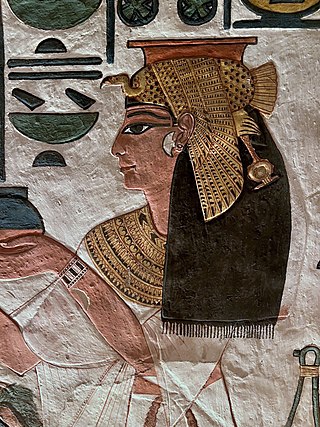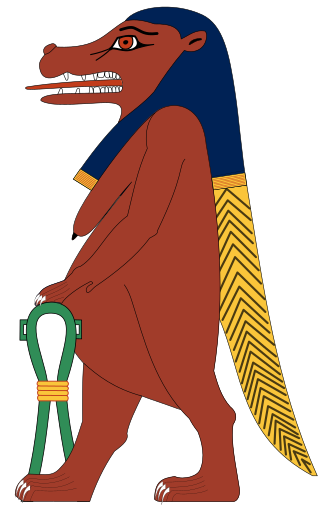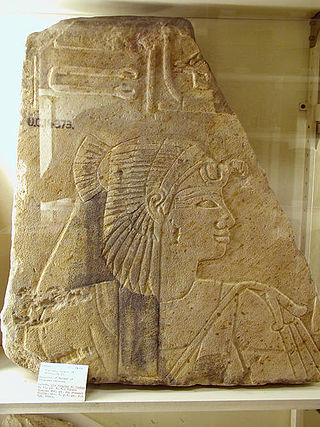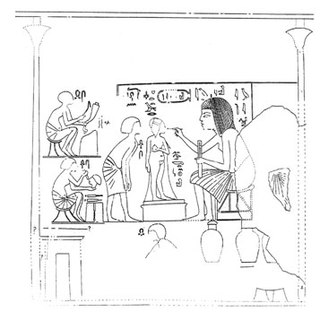
Furniture refers to objects intended to support various human activities such as seating, eating (tables), storing items, working, and sleeping. Furniture is also used to hold objects at a convenient height for work, or to store things. Furniture can be a product of design and can be considered a form of decorative art. In addition to furniture's functional role, it can serve a symbolic or religious purpose. It can be made from a vast multitude of materials, including metal, plastic, and wood. Furniture can be made using a variety of woodworking joints which often reflects the local culture.

Ḥeḥ was the personification of infinity or eternity in the Ogdoad in ancient Egyptian religion. His name originally meant "flood", referring to the watery chaos Nu that the Egyptians believed existed before the creation of the world. The Egyptians envisioned this chaos as infinite, in contrast with the finite created world, so Heh personified this aspect of the primordial waters. Heh's female counterpart and consort was known as Hauhet, which is simply the feminine form of his name.

Nefertari, also known as Nefertari Meritmut, was an Egyptian queen and the first of the Great Royal Wives of Ramesses the Great. She is one of the best known Egyptian queens, among such women as Cleopatra, Nefertiti, and Hatshepsut, and one of the most prominent not known or thought to have reigned in her own right. She was highly educated and able to both read and write hieroglyphs, a very rare skill at the time. She used these skills in her diplomatic work, corresponding with other prominent royals of the time. Her lavishly decorated tomb, QV66, is one of the largest and most spectacular in the Valley of the Queens. Ramesses also constructed a temple for her at Abu Simbel next to his colossal monument there.

In Ancient Egyptian religion, Taweret is the protective ancient Egyptian goddess of childbirth and fertility. The name "Taweret" means "she who is great" or simply "great one", a common pacificatory address to dangerous deities. The deity is typically depicted as a bipedal female hippopotamus with feline attributes, pendulous female human breasts, the limbs and paws of a lion, and the back and tail of a Nile crocodile. She commonly bears the epithets "Lady of Heaven", "Mistress of the Horizon", "She Who Removes Water", "Mistress of Pure Water", and "Lady of the Birth House".

The tomb of Yuya and Thuya, also known by its tomb number KV46, is the burial place of the ancient Egyptian noble Yuya and his wife Thuya, in the Valley of the Kings. They were the parents of Queen Tiye, the chief wife of Pharaoh Amenhotep III. Their tomb was discovered in February 1905 by the Egyptologist James E. Quibell, excavating under the sponsorship of American millionaire Theodore M. Davis. The tomb was robbed in antiquity but preserved a great deal of its original contents including chests, beds, chairs, a chariot, and numerous storage jars. Additionally, the riffled but undamaged mummies of Yuya and Thuya were found within their disturbed coffin sets. Prior to the discovery of the tomb of Tutankhamun, this was considered to be one of the greatest discoveries in Egyptology.
The Workmen's Village, located in the desert 1.2 kilometres (0.75 mi) east of the ancient city of Akhetaten, was built during the reign of the Eighteenth Dynasty pharaoh Akhenaten. It housed the workers who constructed and decorated the tombs of the city's elite, making it comparable to the better studied Theban workers village of Deir el-Medina. Though an isolated part of Amarna, the Workmen's Village provides many well preserved artifacts and buildings allowing archaeologists to gather much information about how society functioned.

Sitamun, also Sitamen,Satamun; Ancient Egyptian: sꜣ.t-imn, "daughter of Amun" was an ancient Egyptian princess and queen consort during the 18th Dynasty.

Amanishakheto was a queen regnant (kandake) of Kush who reigned in the early 1st century AD. In Meroitic hieroglyphs her name is written "Amanikasheto". In Meroitic cursive she is referred to as Amaniskheto qor kd(ke) which means Amanishakheto, Qore and Kandake.

Beketaten was an ancient Egyptian princess of the 18th Dynasty. Beketaten is considered to be the youngest daughter of Pharaoh Amenhotep III and his Great Royal Wife Tiye, thus the sister of Pharaoh Akhenaten. Her name means "Handmaid of Aten".

Nebettawy(nb.t-t3.wỉ; "Lady of the Two Lands") was an ancient Egyptian princess and queen, the fifth daughter and one of the eight Great Royal Wives of Pharaoh Ramesses II.

Amarna Tomb 1 is a sepulchre near Amarna, Upper Egypt. It is the tomb of the ancient Egyptian noble Huya, which is located in the cluster of tombs known collectively as the Northern tombs.

The tomb of Kha and Merit, also known by its tomb number TT8, is the funerary chapel and burial place of the ancient Egyptian foreman Kha and his wife Merit, in the northern cemetery of the workmen's village of Deir el-Medina. Active during the mid-Eighteenth Dynasty, Kha supervised the workforce who constructed royal tombs in the reigns of pharaohs Amenhotep II, Thutmose IV and Amenhotep III. Of unknown background, he probably rose to this position through skill and was rewarded by at least one king. He and his wife Merit had three known children. Kha died in his 50s or 60s, while Merit died before him, seemingly unexpectedly, in her 30s.

The Theban Tomb TT57 is located in Sheikh Abd el-Qurna. It forms part of the Theban Necropolis, situated on the west bank of the Nile opposite Luxor. The tomb is the burial place of the ancient Egyptian official Khaemhat, who was royal scribe and overseer of double granary, during the reign Amenhotep III. The relief decoration of the tomb is regarded as the best of New Kingdom art.

Menhet, Menwi and Merti, also spelled Manhata, Manuwai and Maruta, were three minor foreign-born wives of Pharaoh Thutmose III of the Eighteenth Dynasty. They are known for their lavishly furnished rock-cut tomb in Wady Gabbanat el-Qurud near Luxor, Egypt. They are suggested to be Syrian, as the names all fit into Canaanite name forms, although their ultimate origin is unknown. A West Semitic origin is likely, but both West Semitic and Hurrian derivations have been suggested for Menwi. Each of the wives bear the title of "king's wife", and were likely only minor members of the royal harem. It is not known if the women were related as the faces on the lids of their canopic jars are all different.

Dancing played an important role in the lives of the ancient Egyptians. However, men and women are never depicted dancing together. The trf was a dance performed by a pair of men during the Old Kingdom. Dance groups were accessible to perform at dinner parties, banquets, lodging houses, and even religious temples. Some women from wealthy harems were trained in music and dance. They danced for royalty accompanied by male musicians playing on guitars, lyres, and harps. Yet, no well-bred Egyptian would dance in public, because that was the privilege of the lower classes. Wealthy Egyptians kept slaves to entertain at their banquets and present pleasant diversion to their owners.

Tyti was an ancient Egyptian queen of the 20th Dynasty. A wife and sister of Ramesses III and possibly the mother of Ramesses IV.

Ancient furniture was made from many different materials, including reeds, wood, stone, metals, straws, and ivory. It could also be decorated in many different ways. Sometimes furniture would be covered with upholstery, upholstery being padding, springs, webbing, and leather. Features which would mark the top of furniture, called finials, were common. To decorate furniture, contrasting pieces would be inserted into depressions in the furniture. This practice is called inlaying.
In ancient Egypt, especially during the Early Dynastic and Old Kingdom periods, dwarfs and pygmies were seen as people with celestial gifts. They were treated with considerable respect and could enjoy high social positions. During the 1st Dynasty, dwarfs served and worked directly for the king and royal household, and a number have been found buried in subsidiary tombs around those of the kings. In fact, the rather high proportion of dwarfs in the royal cemeteries of the 1st Dynasty suggests some may have been brought into Egypt from elsewhere.

The Tomb of Panehsy is a sepulchre in Amarna, Upper Egypt. It was erected for the noble Panehsy who bore the titles the First servant of the Aten in the house of Aten in Akhet-Aten, Second prophet of the Lord of the Two Lands Neferkheprure-Waenre (Akhenaten), the sealbearer of the King of Lower Egypt, Overseer of the storehouse of the Aten in Akhetaten, Overseer of cattle of the Aten in Akhet-Aten.

QV60 is the tomb of Nebettawy, the daughter and Great Wife of Ramesses II, in Egypt's Valley of the Queens. It was mentioned by Champollion and Lepsius, and later excavated by Ernesto Schiaparelli.



















